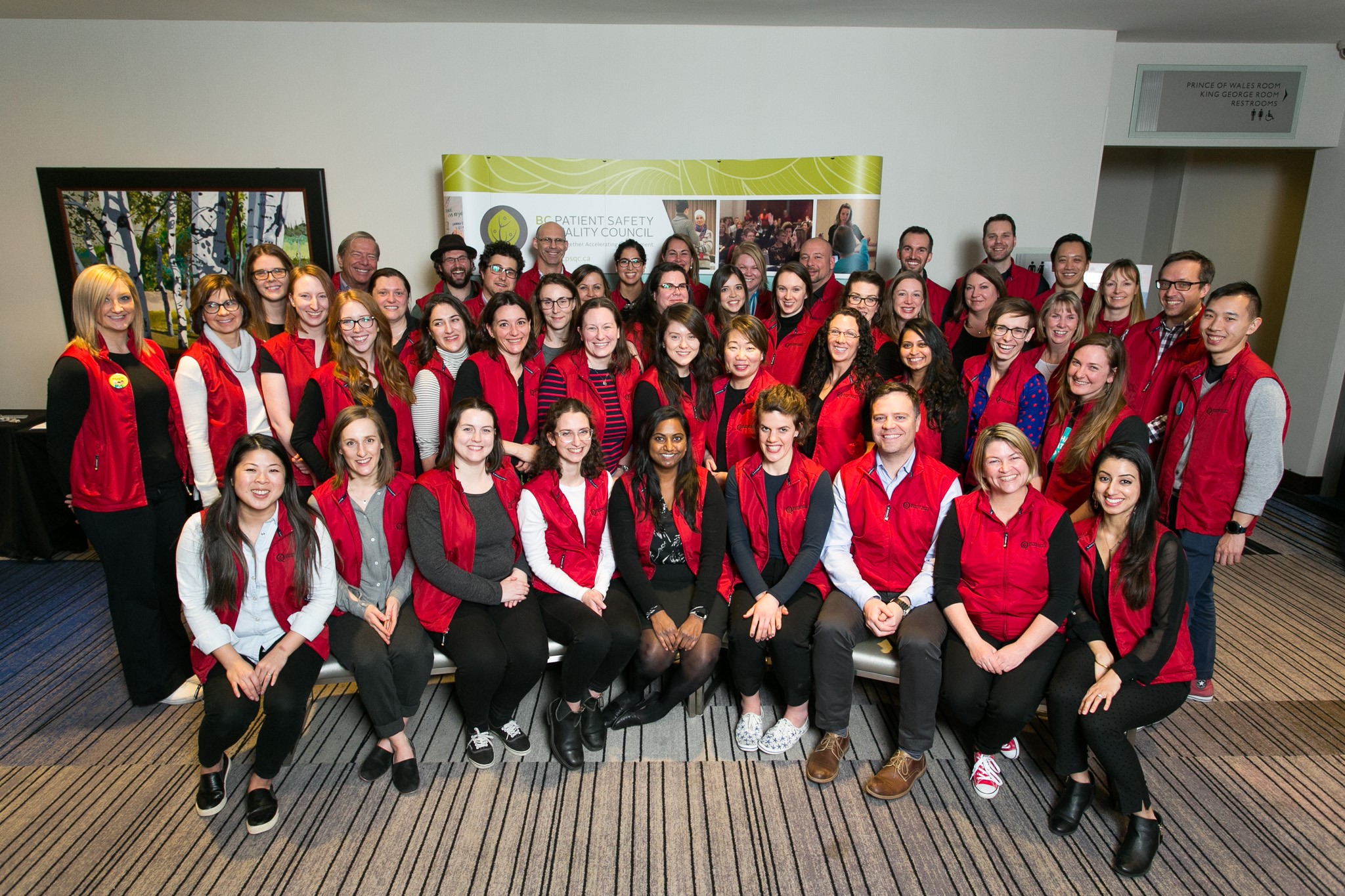Posted
Categories: Working Together for Better Health Care
When the pandemic hit, many people felt helpless. They wanted to do more than bang on pots and pans at 7:00 PM to show solidarity to point-of-care workers and support their communities, but were unsure what to do.
In the North, three people with a shared passion for and commitment to person- and family-centred care got together to brainstorm how they could contribute. Cathy Almost, an Engagement Leader at the BC Patient Safety & Quality Council, Tina Strudsholm, Lead, Person and Community Engagement with Northern Health and the BC SUPPORT Unit Northern Centre, and Lee Cameron, a Physician Quality Improvement Coach at Northern Health, started connecting on Zoom to explore possibilities.
“It was early in the pandemic, and there were really tight restrictions on visitation. That was the context, and the challenge we were facing – how to maintain that connection with family that is required,” shared Tina. Early on, Cathy spotted a resource being shared on Twitter that was developed in the UK and intended to guide health care providers when calling a family about losing a loved one during COVID-19.
The trio was intrigued by the resource and contacted the authors to learn if patients and families had been involved in its development – they had not. So, with the authors’ permission, the team decided to adapt the resource to make it more relevant for their region, by incorporating feedback from people on both sides of the phone call: physicians and families in the North.
“It doesn’t need to be complicated. Simple tools can be useful and make great impact. That can be the challenge sometimes, thinking about a big concept like [person- and family-centred care], it’s helpful to keep it simple and get some momentum from some practical tools,” shared Tina.
Including Patient Voices
Four PVN patient partners from the North were also actively looking for a way to contribute to the COVID-19 response and were keen to jump aboard. In a one-time Zoom meeting, the group discussed the resource in a roundtable format where patient partners offered feedback one at a time.
“I’m always very interested in the language that is used in vulnerable situations and supporting the people working in those situations,” shared patient partner Duane Jackson. “I thought the infographic looked very busy and could be overwhelming to anyone using it as a guide. I think the idea was to make the language a little more accessible and to tone down the appearance a bit.”
A major theme of the feedback was to slow the conversation down and to pause and create more space for compassion. Related to that was the importance of establishing connection at the start of a conversation and asking, not assuming, if it was a good time to talk.
“They suggested more attention be given to ensuring the family member was comfortable and had supports available before getting straight to the (clinical) business of delivering the news. I think those are really effective principles of person- and family-centred care that they brought forward,” reflected Tina.
Two of the patient partners who volunteered are Indigenous and were able to offer additional insights into how restricted visitation rules impacted cultural practices and made it hard to fulfill traditional obligations, which could add to the grief and guilt families might be experiencing. “They also gave us a relational lens, which is very important in an Indigenous world, to how would it feel to have someone phone you to tell you how your loved one is doing, or not doing, or has passed. Getting that feedback was super invaluable,” shared Cathy.
And, according to Tina, “They told us that it’s not just about family being separated, but in many Indigenous communities in the North you have cultural obligations to step up during certain life events and COVID-19 was making it hard to fulfill those roles. It was an excellent contribution and is reflected in the revisions we made.”
Including Physician Voices
With patient feedback incorporated, Lee took the updated resource to a group of five physicians in the northwest who had previously demonstrated a strong interest in person- and family-centred care. They all found it useful, particularly so by one palliative care doctor.
“Even though this was rapid and simple, since they knew that this resource had been vetted by patient partners, it promoted uptake and understanding. A few of the physicians expressed, ‘I hadn’t thought about that.’ [Getting patient feedback first] made it more poignant,” said Lee. “As a Quality Improvement Coach, I hear physicians say that they support the theory and concept of person- and family-centred care, but they ask, ‘What does this look like in a practical, roll-up-your-sleeves kind of way and show us the tools. How can we actually apply this?’ This resource was a great example.”
A New Resource for the North, and Provincial Spread The group made several revisions to improve readability and avoid euphemisms. They also added content, including the best practice framework of ASK TELL ASK, starting with questions to gauge comfort and ensure support for the family member, and acknowledging the challenge of fulfilling various cultural protocols.
The revised resource was implemented by Northern Health’s palliative care department, shared on its physicians’ website and recently featured in its Leadership Digest. Cathy also shared the resource with leadership at the BC Patient Safety & Quality Council and inquired about the possibility of provincial spread. She received quick and enthusiastic responses from Devin Harris, the Council’s Chair, who agreed to spread the resource within Interior Health, where he is the organization’s Executive Medical Director of Quality, Patient Safety and Research. David Sweet, an emergency physician at Vancouver Coastal Health and the Council’s Clinical Lead for Sepsis, asked to share it through the BC Sepsis Network, COVID-19 therapeutics and critical care networks as well as local departments.
“That’s the goal! Having an effect on the health care system by creating something helpful that patients have contributed to,” said Cathy. To the patient partners involved, it was satisfying to know that their comments were being heard, and the resource they contributed to was put into practice.
“The best part of any of the engagement is feeling that you have made a difference in the health care of an individual and to feel that you have supported those that have chosen this field,” shared Duane.
Lessons Learned
When asked about lessons learned that might be relevant for other teams, Tina suggests keeping it simple. “Meaningful engagement can happen quickly. This was really just one meeting. If there is a real commitment to incorporate feedback as much as possible, you can realize some big results with small effort. It doesn’t need to be an overwhelming process. This was nice, because some engagements get pretty long and drawn out, so it was fun to be part of something that was focused,” she shared.

Lee reminds folks not to reinvent the wheel because “Quality improvement is all about sharing resources, what worked, what didn’t work, and considering appropriateness to the local context.” Cathy agrees and encourages efforts to spread learnings. “One of my peeves with the system is that it doesn’t talk to itself, or repeat best practices, or try to teach each other and communicate. So that’s probably what I’m most proud of…how we responded to the pandemic by involving the patient voice and put this together not only for our own organizations, but we succeeded in spreading it province wide which is pretty amazing, in a pandemic, when there is so much else going on,” she shared.
They also note that collaboration is key – across disciplines, departments, organizations and roles. “We came together with a spirit of ’OK, we don’t work at the point of care, but what can we do right now right here in this space, that is going to make a difference?’ It’s the spirit of how you show up. The word collaboration is used a lot, but I think that made all the difference. It was small, nimble. We came from a power-sharing place, and that’s how we showed up,” reflected Lee.
Finally, Duane reminds folks that there is value and power in all perspectives. “The view from one side of the table is much different than from the other side. Your opinion has value in that it sees things differently and experiences the situation socially, emotionally and cognitively in its own way.”
This story was featured in our 2020/21 Annual Report. Read more like it here.


